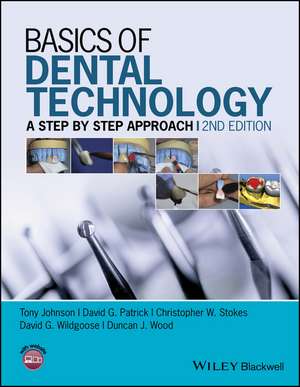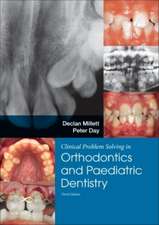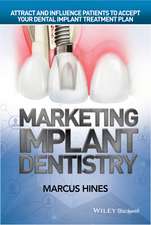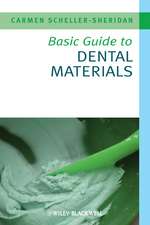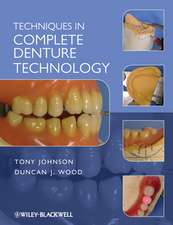Basics of Dental Technology 2e – A Step By Step Approach
Autor T. Johnsonen Limba Engleză Paperback – 24 sep 2015
- Retains the accessible, task–based approach and step–by–step guidance of the first edition
- Features updates throughout, as well as a new chapter on digital dental technology and an interactive student website to support self–assessment
- Explains key competencies, concepts, instruments, and equipment, and also introduces more specialist techniques and procedures, such as denture prosthetics, fixed prosthodontics and orthodontic work
- Provides essential information for trainee dental technicians and students learning about dental technology, including study tips and strategies for working effectively within a dental team
Preț: 326.63 lei
Preț vechi: 343.82 lei
-5% Nou
62.51€ • 65.02$ • 51.60£
Carte disponibilă
Livrare economică 24 martie-07 aprilie
Livrare express 07-13 martie pentru 40.52 lei
Specificații
ISBN-10: 1118886216
Pagini: 200
Dimensiuni: 217 x 279 x 10 mm
Greutate: 0.61 kg
Ediția:2nd Edition
Editura: Wiley
Locul publicării:Chichester, United Kingdom
Public țintă
Trainees in dental technology programs as well as dental students, trainee dental hygienists and nurses learning about dental technology and beginning dental techniciansDescriere
The second edition of Basics of Dental Technology: A Step By Step Approach is a complete reference for the current techniques and materials used in dental technology. It retains the accessible, task–based approach and step–by–step guidance that made the first edition so well regarded by readers. Basics of Dental Technology explains key competencies, concepts, terms, instruments and equipment, from impression handling and model production to tray construction, articulators and facebows. The book then goes on to introduce the basics of more specialist techniques and procedures, such as complete and partial denture prosthetics, fixed prosthodontics, orthodontic work, occlusion and implants.
Updated throughout, this second edition also features a new chapter in digital dental technology as well as interactive student website with self–assessment questions and downloadable images. Attuned to the latest developments and filled with tips and advice, this guide provides essential information for trainee dental technicians and students learning about dental technology.
Textul de pe ultima copertă
The second edition of Basics of Dental Technology: A Step By Step Approach is a complete reference for the current techniques and materials used in dental technology. It retains the accessible, task–based approach and step–by–step guidance that made the first edition so well regarded by readers. Basics of Dental Technology explains key competencies, concepts, terms, instruments and equipment, from impression handling and model production to tray construction, articulators and facebows. The book then goes on to introduce the basics of more specialist techniques and procedures, such as complete and partial denture prosthetics, fixed prosthodontics, orthodontic work, occlusion and implants.
Updated throughout, this second edition also features a new chapter in digital dental technology as well as interactive student website with self–assessment questions and downloadable images. Attuned to the latest developments and filled with tips and advice, this guide provides essential information for trainee dental technicians and students learning about dental technology.
Cuprins
About the Companion Website ix
Chapter 1 INTRODUCTION 1
1.1 Introduction 1
1.2 How to use this book 1
1.3 Equipment and instruments 1
1.4 Health and safety in the dental laboratory 5
1.5 Sterilisation and impression handling 6
1.6 Introduction to model making 8
1.7 Models for prosthodontics casting primary impressions 9
1.8 Models for prosthodontics boxing–in impressions 12
1.9 Models for prosthodontics casting working (secondary) impressions 13
1.10 Models for prosthodontics models for cobalt chromium frameworks 13
1.11 Orthodontic study models 14
1.12 Introduction to sectional models 16
1.13 Producing a sectional model using a tray system (Figure 1.13.1) 17
1.14 Producing a sectional model using a pinned system 19
1.15 Sectioning the model 20
1.16 Introduction to articulating models 22
1.17 Articulating models on a simple hinge articulator 22
1.18 Articulating dentate models using the average position 23
1.19 Articulating edentulous models using the average position 25
1.20 Articulating models using a facebow 26
Chapter 2 Complete Prosthetics 31
2.1 Introduction to complete prosthetics 31
2.2 Construction of a close–fitting custom impression tray 32
2.3 Construction of a tray with spacer for edentulous cases 34
2.4 Construction of a tray for dentate or partially dentate cases 35
2.5 Construction of a windowed close–fitting tray 37
2.6 Construction of occlusal registration rims 38
2.7 Setting up denture teeth 42
2.8 Denture processing 47
2.9 Grinding and finishing the dentures 53
2.10 Denture repair 57
2.11 Relining a denture in the laboratory 60
2.12 Copy dentures 62
Chapter 3 Partia l Prosthetics 65
3.1 Introduction to partial prosthetics 65
3.2 Classification 65
3.3 Component parts of partial dentures 66
3.4 Surveying 68
3.5 Designing partial dentures 71
3.6 Partial denture construction acrylic resin 75
3.7 Partial denture construction cobalt chromium 77
Chapter 4 FIXED PROSTHODONTICS 85
4.1 Restoration design 85
4.2 Metal restorations 86
4.3 Ditching the die 88
4.4 Producing a wax pattern 88
4.5 Investing the wax pattern 90
4.6 Casting and de–vesting the pattern 92
4.7 Finishing the casting 94
4.8 Metal–ceramic restorations 98
4.9 Producing a wax pattern for a metal bonded to ceramic framework 99
4.10 Investing the wax pattern 102
4.11 Casting the pattern 102
4.12 De–vesting and surface preparation 104
4.13 Ceramic application and build–up 105
4.14 Ceramic restorations 112
4.15 Producing a high–strength ceramic substructure 114
4.16 Veneering a high–strength ceramic substructure 115
4.17 Producing a resin–bonded crown on a refractory die 115
4.18 Post crowns 117
4.19 Bridges 118
4.20 Producing a cast metal fixed fixed restoration 121
4.21 Producing a soldered metal fixed fixed restoration 122
4.22 Soldering 123
4.23 Minimal preparation bridges 125
4.24 Producing a minimal preparation bridge (Maryland technique) 126
4.25 Digital dentistry 128
4.26 Using a laboratory–based CAD CAM system 131
4.27 Producing a posterior single–unit substructure or restoration using a reduction technique 132
4.28 Producing a bridge substructure 134
4.29 Removable Partial Denture Design 134
4.30 Implant–supported prosthodontics 139
Chapter 5 ORTHODONTICS 141
5.1 Introduction to orthodontics 141
5.2 Classification of malocclusions 142
5.3 Theory of tooth movement 143
5.4 Basic wire bending techniques 144
5.5 Making passive components 146
5.6 Producing ball–ended clasps 146
5.7 The Adams clasp 147
5.8 Producing a southend clasp 148
5.9 Active appliances 149
5.10 Palatal finger spring (guarded) 150
5.11 Making a T–spring 152
5.12 Double cantilever or Z–spring 152
5.13 Buccal canine retractor 153
5.14 The Roberts retractor 154
5.15 Producing baseplates 155
5.16 Producing biteplanes 156
5.17 Extra–oral anchorage 156
5.18 Functional appliance design 157
5.19 Producing an Andresen appliance 157
5.20 Twin–block appliance 158
5.21 Fixed orthodontic appliances 160
5.22 Retainer appliance design 160
5.23 Repair and modification of orthodontic appliances 162
5.24 Making tooth positioners 164
5.25 Sports Mouthguards 165
Chapter 6 Occlusion 167
6.1 Introduction to occlusion 167
6.2 Occlusal schemes 168
6.3 Articulators 170
6.4 Facebows 171
6.5 Summary 171
Chapter 7 Shade, Colour and Size Determination for Denta l Appliances 173
7.1 Introduction to aesthetics 173
7.2 Colour terminology 173
7.3 Shade guides 173
7.4 Selecting teeth for complete denture patients 175
Appendix Tooth Morphology 177
Glossar y 179
Index 181
Notă biografică
Dr Tony Johnson is Senior Lecturer in the Academic Unit of Restorative Dentistry and Head of the Dental Technology Unit at the School of Clinical Dentistry at the University of Sheffield, UK.
Dr David G. Patrick is a University Teacher in the Dental Technology Unit, Academic Unit of Restorative Dentistry at the School of Clinical Dentistry at the University of Sheffield, UK.
Dr Christopher W. Stokes is Senior University Teacher in the Academic Unit of Restorative Dentistry at the School of Clinical Dentistry at the University of Sheffield, UK.
Mr David G. Wildgoose until his retirement in 2009 was a Dental Instructor in the Dental Technology Unit, Academic Unit of Restorative Dentistry at the School of Clinical Dentistry at the University Sheffield, UK.
Dr Duncan J. Wood is a Senior University Teacher in the Dental Technology Unit, Academic Unit of Restorative Dentistry at the School of Clinical Dentistry at the University of Sheffield, UK.
